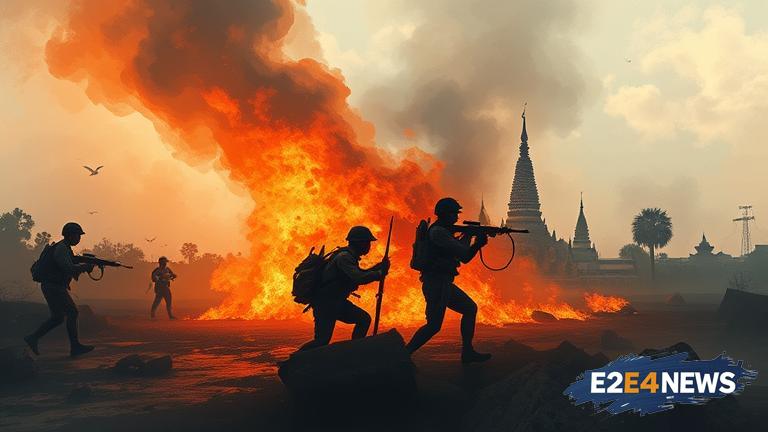The conflict between Thailand and Cambodia has been ongoing for years, with tensions rising over a disputed border area near the ancient Preah Vihear temple. Despite efforts to negotiate a ceasefire, the violence has continued to escalate, with both countries exchanging artillery fire and blaming each other for the aggression. The latest clashes have resulted in several deaths and injuries, with thousands of civilians forced to flee their homes. The Thai military has accused Cambodian troops of firing into Thai territory, while Cambodia has claimed that Thai forces have been attacking its soldiers. The situation has been further complicated by the fact that the border area is heavily mined and has been the site of numerous clashes in the past. The international community has called for calm and restraint, with the United Nations urging both countries to respect the ceasefire agreement. However, with neither side showing any signs of backing down, the conflict is likely to continue. The Thai government has vowed to protect its sovereignty and territorial integrity, while Cambodia has accused Thailand of trying to provoke a war. The conflict has also had a significant impact on the local economy, with trade and tourism suffering as a result of the violence. The situation is being closely monitored by neighboring countries, with Indonesia and Vietnam offering to help mediate the conflict. The United States has also expressed concern over the violence, calling for both sides to exercise restraint. Despite the efforts of the international community, the conflict shows no signs of abating, with both countries dug in and refusing to back down. The Thai military has been accused of using excessive force, while Cambodian troops have been blamed for firing into civilian areas. The conflict has also raised concerns over the potential for wider regional instability, with other countries in the region watching the situation closely. The Association of Southeast Asian Nations (ASEAN) has called for an emergency meeting to discuss the conflict, with the organization’s secretary-general urging both countries to respect the ceasefire agreement. The conflict has also had a significant humanitarian impact, with thousands of people displaced and in need of assistance. The international community has pledged to provide aid to those affected by the conflict, with the United Nations launching an appeal for emergency funding. However, with the conflict showing no signs of abating, the situation is likely to continue to deteriorate. The Thai and Cambodian governments have been accused of failing to protect their citizens, with both sides prioritizing military action over diplomacy. The conflict has also raised questions over the role of the international community in preventing and resolving conflicts, with some critics arguing that more needs to be done to prevent the escalation of violence. As the situation continues to unfold, it remains to be seen whether a ceasefire can be negotiated and the conflict brought to an end. The international community will be watching the situation closely, with the hope that a peaceful resolution can be found. The conflict has also highlighted the need for greater regional cooperation and diplomacy, with the ASEAN organization playing a key role in promoting peace and stability in the region. The Thai and Cambodian governments must prioritize diplomacy and work towards a peaceful resolution to the conflict, rather than relying on military action. The international community must also do more to support the people affected by the conflict, providing humanitarian aid and promoting a peaceful resolution to the violence.





